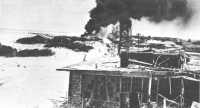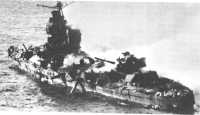Chapter 4: Midway versus the Japanese, 4-5 June 1942
A Midway PBY spotted the approaching Japanese first, at about 0900 of June 3,1 and tracked them long enough to report eleven ships making 19 knots eastward. These vessels were probably the transport and seaplane groups of the Occupation Force, and they were attacked at 1624 by nine B-17s which Captain Simard sent out following the PBY’s contact report. The pilots reported having hit “two battleships or heavy cruisers” and two transports in the group then 570 miles away from Midway, but the fliers were mistaken in both ship identification and in calling their shots, for they actually hit nothing. A Catalina scored on one of these oilers later that night in a moonlight torpedo run.
This was enough to convince Fletcher that the battle would soon be on, and he changed course from his station 300 miles east-northeast of Midway to gain a new position about 200 miles north. From there he could launch his planes the following morning against the Japanese carrier force which was expected to come in from the northwest. U.S. intelligence still was good. Nagumo continued to steam in from the northwest while his transports were under attack, and near daybreak on 4 June, when the Yorktown launched an early-morning search and while 11 PBYs were going up to patrol from Midway, he had reached a position approximately 250 miles northwest of the atoll. There at 0430 the Japanese admiral launched 36 “Kate” torpedo planes and 36 “Val” dive bombers, plus 36 escorting Zeros, for the first strike against the atoll.
At 0545 one of the Midway PBYs sighted these planes about 150 miles out from the island, and a short time later another PBY reported visual contact with two enemy carriers and the balance of the Japanese Carrier Striking Force some 200 miles from Midway. Enterprise intercepted this report, but Fletcher wanted to recover his search planes and sift further intelligence before launching his strike, and so he ordered Spruance to take the van southwesterly and lead off the attack against the enemy carriers.
Meanwhile the Midway Marines were ready for the first shock of attack. Ground force defenders at general quarters manned every weapon and warning device, and MAG-22, which already had fighters up to cover the sorties of the PBYs stood by for orders. At 0555, shortly after the second PBY report had fixed the position of the Japanese Striking Force, the 6th Defense Battalion radar logged a report of “many planes,” and the Naval Air Station raised similar blips almost simultaneously. Air raid sirens began to wail, Condition One was set, and the MAG-22 pilots manned their planes. Both squadrons were in the
Camouflaged lookout tower at Sand Island stands amidst the damage caused by Japanese dive bombers which attacked Midway Atoll on 4 June 1942. (USN 17057)
Japanese cruiser Mikuma, sunk at the Battle of Midway, lies battered and smoking from the attacks of pilots of MAG-22 and the American carriers. (USN 11528)
air in less than 10 minutes, VMF-221 heading to intercept the enemy planes and VMSB-241 off to rendezvous station 20 miles east where the dive bomber pilots would receive further instructions.
The VMF fliers under Major Floyd B. Parks sighted the Zero-escorted Val dive bombers at 0616 about 30 miles out from Midway, and Captain John F. Carey, leading one of Parks’ divisions in an F4F-3, launched the attack from 17,000 feet. The Marine fliers were hopelessly outnumbered, and they found that the Zero fighters could “fly rings around them.” they had time for only one pass at the bombers, and then had to turn their attention to the swarm of Zeros, from one to five of which got on the tail of each Marine fighter. Only three of the original 12 Marine pilots survived this brawl, and although the damage they inflicted on the enemy has never been assessed, it is believed that they splashed a number of the bombers and some of the Zeros. Other Zeros were led into the Midway antiaircraft fire.
Meanwhile another group of 13 Midway fighters under Captain Kirk Armistead came in for an attack against the enemy air formation. Again the damage inflicted upon the enemy was undetermined, but fewer Marine pilots were lost. For better or for worse, however, the fighter defense of Midway had been expended, and the problem now passed to the antiaircraft guns on the atoll.
The first Japanese formation attacked at about 0630 from 14,000 feet. Antiaircraft fire knocked down two of these horizontal bombers before they could unload, but 22 came on through to drop their bombs. And just as these initial explosions rocked the two islands, 18 planes of the enemy’s second wave came over for their strike. Since each of these Japanese formations had left the carriers with 36 planes, it is possible that the Marine fliers scored some kills.2
The Kaga aircraft group in the first wave, assigned to attack the patrol plane facilities on Sand Island, dropped nine 242-kilogram bombs on and about the seaplane hangars, setting them aflame and starting a large fire in the fuel oil tanks 500 yards to the north. The Akagi planes plastered the north shore of Eastern Island to destroy the Marine mess hall, galley, and post exchange. These the returning enemy fliers described as hangars.3 Other targets of the Japanese dive bombers included the already-flaming fuel storage at the north end of Sand Island, the Sand Island dispensary, and the Eastern Island powerhouse which suffered direct hits from two 805-kilogram bombs. These hits virtually destroyed the entire plant. And at the very end of the strike, the 6th Defense Battalion’s Eastern Island command post received a direct hit which killed the Marine sector commander, Major William W. Benson, and wounded several other men. After these bombers completed their runs, the Zeros came in for strafing attacks. This one and only air strike on Midway was over shortly after 0700.
Marine defense batteries fired throughout these attacks, and one source credited this antiaircraft fire with 10 kills.4 Reports from Marine flyers would appear to require an increase of this estimate, however, since returning Midway pilots described enemy planes falling out of formation and other foundering into the water.5 But Japanese authorities claim that only six of their planes—three level bombers, two dive bombers, and a fighter—failed to make it back to the carriers.6 This controversy probably will never be resolved, for regardless of how many of these Japanese planes made it back to their carrier decks, Fletcher and Spruance—with a certain unintentional assistance from Nagumo—initiated action which resulted in the destruction of all these planes, anyway.
Nagumo’s mistake was a natural one for a commander who believed himself to be unopposed on a “field” of battle of his own choice. Lieutenant Joichi Tomonaga, the flight officer who had commanded the first attack wave against Midway, radioed during his return fight that “There is need for a second attack wave.” Meanwhile, with Nagumo still ignorant of the U.S. fleet’s presence in the vicinity, six American TBFs and four B-26s from Midway came in to attack his ships. This convinced the Japanese admiral that Tomonaga was right, and he sent below to hangar spaces the 93 planes he had kept spotted for strikes against possible surface opposition. These planes were to be re-armed with bombs for the second strike. Then Nagumo called in the returning planes to arm them for the new attack on the atoll. While his men were involved in this work on the flight deck and in hangar spaces, Nagumo got the belated word from a Tone search plane that U.S. ships, including at least one carrier, were in the area. This caused another change of mind, and the admiral ordered the planes’ ordnance changed again, from bombs back to torpedoes with which to attack the surface ships. But this decision was just tardy enough to allow Spruance to catch him with his planes down, and with torpedoes and bombs strewn in great confusion about the hangar deck.7
Meanwhile, as Nagumo vacillated, Admiral Nimitz’s orders for Captain Simard to “go all out for the carriers,” while Marine antiaircraft batteries worried about Midway, were under execution. VMSB-241, like the fighter squadron, had divided into two striking units, the first composed of 16 SBD-2s led by Major Lofton Henderson, and the second of 11 SB2U-3s commanded by Major Benjamin W. Norris. Hendersons’ group climbed to 9,000 feet to locate the enemy carriers, which were then undergoing the attack from the TBFs and the B-26s. Fliers of this group sighted the Japanese ships at 0744, but as the SBDs spiraled down they were set upon by swarms of Nakajima 97s and Zeros flying air cover, which were soon reinforced by more fighters from the carriers below. Henderson and several other were shot down (only eight of these planes got back to Midway) and the strike scored no hits although some were claimed.8
Next came an attack by 15 B-17s led by Lieutenant Colonel Walter C. Sweeney, USA, but again claims of hits were optimistic. And as these Flying Fortresses pulled away, Major Norris came in with his 11 Vindicators which had taken off with Henderson. Beset by the Zeros, Norris turned to the nearest target at hand, and the Marines crowded their ancient planes into a standard glide run almost on top of the Japanese battleship Haruna—previously claimed as an Army B-17’s victim off Luzon. Some of the fliers also went after the Kirishima, which was nearby, but neither attack managed any hits. Three Marines were shot down, and the group was credited with splashing two enemy fighters, plus two probables.9
By 1100 all surviving Marine aircraft had made their way back to the atoll where all hands grimly assessed the battle’s damage and prepared for subsequent action. Of the VMF-221 fighters which had gone in against the attacking Japanese planes, only 10 returned, and of this number only two were in shape to leave the ground again. Thirteen F2A-3s and two F4Fs were missing, along with the eight craft lost from the Henderson group and the three shot away from the Norris force. Slick black smoke from oil fires billowed up from the islands, and ruptured fuel lines left more than two-thirds of the aviation fuel temporarily unavailable. Gasoline had to be sent to the field from Sand Island, and hand-pumped from drums. The Marine ground defense force had sustained 24 casualties, and four ordnance-men of VMF-221 had been lost to a direct bomb hit.
At 1700 a burning enemy carrier was reported 200 miles northwest of Midway, and Major Norris prepared VMSB-241’s six operational SBD-2s and five SB2U-3s for a night attack. The planes took off at 1900, but could not find the carrier. Major Norris failed to return from this mission, although the other pilots managed to home by the light of oil fires and the antiaircraft searchlights which were turned up as beacons.10 Meanwhile, the Battle of Midway had been decided at sea in a fight of carrier aircraft.

